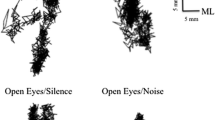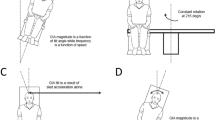Abstract
Current models for physiological components and a posture control experiment conducted with three normal subjects form the basis for a model which seeks to describe quantitatively the control of body sway when only vestibular motion cues are used. Emphasis is placed on delineating the relative functional roles of the linear and the angular acceleration sensors and on modeling the functional interface between these sensors and the initiation of compensatory responses at the ankle joint.
The model predicts the form of the postural response to a small sway disturbance; including initial detection of sway, characteristics of the transient correction, and maintenance of stability. The model suggests that postural stability requires a short time constant integration of semicircular canal output. Separation of semicircular canal and utricular otolith function into sway motion detector and static reference sensors respectively is demonstrated.
Similar content being viewed by others
References
Buller, A. J., Lewis, D. M.: The rate of tension development in isometric tetanic contractions of mammalian fast and slow skeletal muscle. J. Physiol. (Lond.) 176, 337 (1965).
Dempster, W. T.: Space requirements of the seated operator. WADC-TR-55-159, 194 (July 1967).
Hill, A. V.: The heat of shortening and the dynamic constants of muscle. Proc. Roy Soc. B126, 136 (1938).
Katz, B.: The relation between force and speed in muscular contraction. J. Physiol. (Lond.) 96, 45 (1939).
Magdaleno, R. E., McRuer, D. T.: A closed loop neuromuscular system explanation of force disturbance regulation and tremor data. NASA-SP-192, 527 (1968).
McPhedran, A. M., Wuerker, R. B., Henneman, E.: Properties of motor units in homogeneous red muscle (soleus) of the cat. J. Neurophysiol. 28, 71 (1965).
McRuer, D. T., Magdaleno, R. E., Moor, G. P.: A neuromuscular activation systems model. NASA-SP-144, 281 (1967).
Meiry, J. L.: The vestibular system and human dynamic space orientation. NASA-CR-628 (1966).
Nashner, L. M.: A model describing vestibular detection of body sway motion. Acta oto. laryng. (in press).
Stark, L., Houk, J. C., Willis, P. A., Elkind, J. I.: The dynamic characteristics of a muscle model used in digitalcomputer simulation of an agonist-antagonist muscle system in man. Quart. Prog. Rep. RLE MIT 64, 309 (1962).
Wilkie, D. R.: The relation between force and velocity in human muscle. J. Physiol. (Lond.) 110, 249 (1950).
Young, L. R.: The current status of vestibular system models. Automatica 5, 369 (1968).
— Meiry, J. L.: A revised dynamic otolith model. Aerospace Med. 39, 606 (1968).
Author information
Authors and Affiliations
Additional information
This work was supported by NASA under Grant NGR-22-009-156.
Rights and permissions
About this article
Cite this article
Nashner, L.M. Vestibular postural control model. Kybernetik 10, 106–110 (1972). https://doi.org/10.1007/BF00292236
Received:
Issue Date:
DOI: https://doi.org/10.1007/BF00292236




